
Young's Magic Will be Missed in Muskegon
By
Tom Kendra
Special for MHSAA.com
January 10, 2018
Muskegon High School’s historic Hackley Stadium was not an easy place for Gene Young to navigate in recent years, with his hulking 6-foot-6 frame slowed by neuropathy in both feet and worsened this past fall by a nasty infection on his left heel.
 But few people have ever been more positive than Young, a giant – literally and figuratively – in the Muskegon area sports, broadcasting and education communities who died on Jan. 2 at the age of 76.
But few people have ever been more positive than Young, a giant – literally and figuratively – in the Muskegon area sports, broadcasting and education communities who died on Jan. 2 at the age of 76.
Young was determined to make it up to the Hackley Stadium press box back on that August day last fall, to broadcast the Big Reds’ opening game against Ann Arbor Pioneer with myself and play-by-play man Larry Taylor on Muskegon radio station WMUS-FM 107.9 – kicking off his 39th year as the voice of high school football on the lakeshore.
The first challenge was parking.
“Tommy, pull into that lot across from the gate. I know the people working there,” said Young, who seemingly knew everybody, everywhere.
Gene rolled down his window and I couldn’t hear his exact words, but I know he gave $10 instead of the $5 charge (the proceeds were going to help out Muskegon’s minor sports programs). He also put a smile on that parking lot attendant’s face and made him feel like the most important part of the entire game-day operation.
That’s the Gene Young magic.
The next hurdle was crossing Sanford Street and getting into the stadium.
Back in his heyday, Gene was a fantastic athlete, a standout big man and 1959 graduate of Muskegon Heights High School, who accepted a basketball scholarship to Central Michigan University and played on the varsity basketball team as a freshman. He transferred to Otero Junior College in Colorado for one year, before playing his final two years for Weber State University in Utah, coached by NBA legend Dick Motta.
But this past fall, crossing the street was getting to be a challenge.
 The gate attendant spotted him making his way slowly across Sanford with his cane and began undoing the padlocked gate. Young never needed to show a press credential in the Muskegon area, as he and his buddy Jim Moyes had been the voice and the spirit of Muskegon-area high school sports since they first started working together in 1978. The two filled their broadcasts with memories and insights brought in from their deep knowledge of Muskegon’s sports history.
The gate attendant spotted him making his way slowly across Sanford with his cane and began undoing the padlocked gate. Young never needed to show a press credential in the Muskegon area, as he and his buddy Jim Moyes had been the voice and the spirit of Muskegon-area high school sports since they first started working together in 1978. The two filled their broadcasts with memories and insights brought in from their deep knowledge of Muskegon’s sports history.
As Gene and I were let in, many of the fans who still had to wait snickered a bit. Gene diffused the situation quickly, as only he could.
“We’re big time; we’re with ESPN,” he deadpanned.
The next part of the journey is walking down the dark tunnel and up a short ramp where you then experience that first glimpse of the hallowed ground at Hackley Stadium – it’s a moment that Muskegon locals would equate with going around “the curve” near Pere Marquette Park and seeing that first view of Lake Michigan, or an 8-year-old’s first visit to Disneyland. As he plopped down on the handicap bench up front to rest, no one knew it would be his final time to experience that thrill.
Shame on me for not appreciating that moment as I should have, because I was nervously scurrying up the bleachers to set up our radio equipment.
When I glanced down, Gene was holding court on that bench as a steady stream of folks stopped by to shake his hand.
 Some of them were old education friends like Roger Hoekenga, a retired Muskegon Public Schools administrator who stopped to talk about retirement. Gene began his teaching and coaching careers at Muskegon Reeths-Puffer, but is best known for his 26-year run as the Director of Community Education, Adult Education and Recreation at Fruitport. Upon his retirement, he specialized in helping school boards make good hires for superintendent and other administrative positions.
Some of them were old education friends like Roger Hoekenga, a retired Muskegon Public Schools administrator who stopped to talk about retirement. Gene began his teaching and coaching careers at Muskegon Reeths-Puffer, but is best known for his 26-year run as the Director of Community Education, Adult Education and Recreation at Fruitport. Upon his retirement, he specialized in helping school boards make good hires for superintendent and other administrative positions.
Terri Clock, the lone woman on the Muskegon Area Sports Hall of Fame board, then stopped to visit for a few moments. One of Gene’s crowning achievements had been his tireless work for the local sports hall, taking over as president in 1994 and serving in that role until his death.
“He is the hall of fame. When Dick Hedges (the first president of the MASHF) passed away, Gene took over and that was his baby,” said Moyes, who delivered a powerful eulogy at Young’s funeral service on Jan. 6. “He put hours and hours into making our hall of fame the best one. Everything was always first class with Gene.”
The equipment was all set up, and I had already done a test call with the station – and my partner was still sitting on that bench.
I just shook my head and smiled. His friends and family (and especially his wife, Sandy) were used to “Gene speed” – whether it was making his way past all of the characters at the bar to get to our table for lunch every Friday, or visiting with each of the workers on his way to the pool at the health club, or shaking everyone’s hand after church on Sunday.
 Muskegon head coach Shane Fairfield also stopped quickly to chat, thanking Gene for sending him a note of encouragement all four times his teams lost in MHSAA championship games (Fairfield told me at Gene’s visitation that he received another note this year after the Big Reds won the Division 3 title). Then, finally, Gene had a brief word with Muskegon star quarterback La’Darius Jefferson, who experienced Gene’s handshake grip, which he kept locked on until he was ready to let you go.
Muskegon head coach Shane Fairfield also stopped quickly to chat, thanking Gene for sending him a note of encouragement all four times his teams lost in MHSAA championship games (Fairfield told me at Gene’s visitation that he received another note this year after the Big Reds won the Division 3 title). Then, finally, Gene had a brief word with Muskegon star quarterback La’Darius Jefferson, who experienced Gene’s handshake grip, which he kept locked on until he was ready to let you go.
Only then did he start his trek up the 28 concrete rows to the Hackley Stadium press box, which included two or three more stops to rest/visit with Muskegon and Ann Arbor Pioneer fans, before he finally got to his spot at 6:25 p.m. – 5 minutes before air time.
“Tommy Kendra, I picked up some good information down there,” he said.
Those words struck me that day, and I learned a valuable lesson. As I sat there alone in the middle of the press box, sweating profusely, bored and isolated, poring over relatively meaningless stats that I already knew by heart, I realized that he was doing it the right way.
I’ve determined that the best way to honor and remember my dear friend and mentor is to never be in too big of a rush to get into the press box, to get a seat at the lunch table or a treadmill at the gym. Take it a little slower. Be interested in other people. Figure out a way to use your God-given gifts to help them. Brighten their day. And, in the process, learn a few things and gain a new perspective.
That’s the Gene Young magic.
 Tom Kendra worked 23 years at The Muskegon Chronicle, including five as assistant sports editor and the final six as sports editor through 2011. E-mail him at [email protected] with story ideas for Muskegon, Oceana, Mason, Lake, Oceola, Mecosta and Newaygo counties.
Tom Kendra worked 23 years at The Muskegon Chronicle, including five as assistant sports editor and the final six as sports editor through 2011. E-mail him at [email protected] with story ideas for Muskegon, Oceana, Mason, Lake, Oceola, Mecosta and Newaygo counties.
***
Ludington’s Beckman Came Home, Gave Back
Rod Beckman never really got away from high school sports.
Beckman, who died on Dec. 20 at the age of 69 after a five-year battle with cancer, is remembered as one of the best all-around athletes to ever come out of Shelby High School – good enough to earn a Division I basketball scholarship to Oklahoma State University and later shift gears and play three years of professional baseball in the Detroit Tigers organization.
Then Beckman went back to high school, in a way, as the voice of Ludington High School sports for 40 years, from 1972 to 2012, at radio station WKLA in Ludington, where he worked as a popular disc jockey by day.
Beckman also made an impact on high school sports as a well-known and respected baseball and softball umpire in Mason County for more than 25 years.
Ultimately, Beckman stayed involved in sports throughout his life as an outlet for his competitive nature and a way to spend quality time with family and friends. His passion for basketball and baseball later gave way to fast-pitch softball and golf, but he also did his share of bowling, hockey and racquetball. Beckman is a member of the Mason County Sports Hall of Fame.
Beckman used his popularity and name recognition to help others right up until his death.
In September, Beckman hosted the Rod Beckman Cancer Charity Golf Classic, which raised more than $70,000 for the Spectrum Health Ludington Hospital Cancer Patient Assistance Fund and The Optimist Childhood Cancer Campaign.
Beckman is survived by his wife of 21 years, Traci.
– Tom Kendra
PHOTOS: (Top) Gene Young, left, with his most recent broadcasting team of Larry Taylor (second from left) and Tom Kendra, and halftime guest Justin Abdelkader of the Detroit Red Wings, during a 2016 game. Young was working for iHeart Media station WMUS-107.9 FM in Muskegon. (Middle) The legendary broadcast duo of Young, left, and Jim Moyes, call the Class D championship game in 2002. (Below) Young poses in front of the Muskegon Area Sports Hall of Fame displays at the L.C. Walker Arena in downtown Muskegon. Young served as president of the MASHF for the past 24 years.
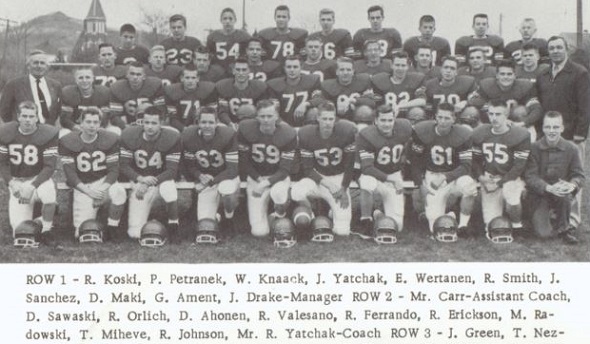
Memorable Wakefield Run Won't Be Forgotten
October 2, 2019
By Ron Pesch
Special for Second Half
When it comes to football, Russ Maki wears his heart on his sleeve. A 1971 graduate of Wakefield High School, he’s on a mission.
As a 7-year-old, he fell in love with the sport and, in particular, with a team.
“My Dad brought me to every (Wakefield) game,” he recalled. “We lived four blocks from the football field, and I watched every morning and afternoon practice.”
Maki’s memories are of the 1960 Cardinals, and he’s on a quest to honor the team.
Football began in 1920 at Wakefield. Interrupted briefly for a national crisis, it returned to the gridiron stronger than ever – but then, until recently, disappeared from the landscape of this Upper Peninsula town. Like in other cities across the nation, shrinking enrollments have impacted the sport.
“(That 1960) team just kicked everybody's butt,” added Maki. “The players on this team were my heroes then and still are to this day. Hardly anybody in town knows they were State Champs.”
Football state championships in Michigan are decided on the playing field via a tournament these days. But that wasn’t the case when Maki was a kid.
Hence, his challenge. He would like the school district to honor the team with recognition such as a pennant to hang in the gym. So he needs proof.
Big Iron
The City of Wakefield proudly notes that it is located in the heart of Big Snow country. Indeed, nearby are three of the finest ski hills in the Midwest. Located in the center of town is Sunday Lake. Porcupine Mountains State Park and Lake Superior are a little north. It is beautiful country.
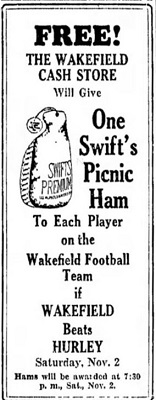 But it wasn’t snow, scenic waterways or quality of life that initially attracted folks to the Gogebic Range area of Michigan. Rather, it was the discovery of iron ore in 1881. The find inspired a mad rush to capitalize, and that led to the founding of the village of Wakefield in 1887. The city was incorporated in 1919.
But it wasn’t snow, scenic waterways or quality of life that initially attracted folks to the Gogebic Range area of Michigan. Rather, it was the discovery of iron ore in 1881. The find inspired a mad rush to capitalize, and that led to the founding of the village of Wakefield in 1887. The city was incorporated in 1919.
Hop on highway US-2, head west, and around 10 minutes later, you’ll be in Wisconsin. Stay on US-2, jog a bit to the north, and in two hours you’ll find yourself in Duluth, Minnesota. A trip from Wakefield to Fargo, ND, is six and a half hours. For comparison, a visit to Detroit, with traffic cooperating, would require a commitment of at least nine hours.
So it’s completely understandable that, from the beginning, Hurley High School – located a mere 13 miles away in the Badger State – became a rival.
“The Wakefield high school football team will meet Hurley on the local grounds Saturday afternoon,” announced the Ironwood Daily Globe on October 20, 1920. According to Coach (Fred) Hackett, who has charge of the team, the boys are light and newly organized and have only a fair chance of winning the game with Hurley.”
Indeed, it was a mismatch, with Hurley trouncing the “green but willing youngsters” from Wakefield, 46-6.
“In the two weeks that the Wakefield team has been out in uniform, Coach Hackett had little time to even drill some of the youngsters in ordinary tactics of the game, much less develop a strong team.”
The schools met again in 1921 with similar result, but continued to play each other sporadically in the coming years. A field goal by Pat O’Brien with eight seconds left to play in the 1929 contest gave Wakefield a 23-20 victory over its natural rival, sealing the school’s first ever unbeaten (but once tied) season.
“A local grocery store offered a free ham to each player on the team if they beat Hurley in that season-ending game,” said Maki, laughing. “Can you imagine that?”
They became league rivals when both teams, along with Bessemer and Ironwood from Michigan and Ashland from Wisconsin, became charter members of the Michigan-Wisconsin Conference in 1937.
Hopes for a different moniker, “for brevity’s sake,” were tossed around by the press at the time. The ‘Big Five’ was pitched by the Iron Mountain News. The Ironwood Daily Globe suggested ‘Michwico’, a juxtaposition of the words Michigan, Wisconsin and Conference. Another thought was the ‘WHABI’, a combination or first letters from each member town.
Instead, as time wore on, the league simply became known as the “M-W.”
Alumnus comes home
Wakefield discontinued football for two years – some say three – due to World War II. The team returned in the fall of 1945. Ansel Anderson, a graduate of league rival Ashland and Stout Institute in Menomonie, Wis. – where he took part in basketball, track and captained the football team – guided the athletic squads at Wakefield for two seasons.
In 1947, the school hired one of its own.
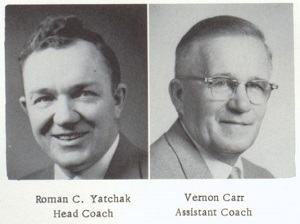 Roman Charles Yatchak had starred in both football and basketball at Wakefield, earning all-U.P. honors in the early 1930s, then lettered in football, basketball and baseball at Iowa State Teachers College. He coached prep ball in Iowa, then at Highland Park in metro Detroit before returning to Wakefield. A year earlier, the Cardinals became members of the newly formed Western Upper Peninsula Football Conference, comprised of Class ‘C’ schools from Houghton, Hancock, L’Anse, Ontonagon, Lake Linden and Crystal Falls. The 1947 season would be the first during which each member played one game against all the other members.
Roman Charles Yatchak had starred in both football and basketball at Wakefield, earning all-U.P. honors in the early 1930s, then lettered in football, basketball and baseball at Iowa State Teachers College. He coached prep ball in Iowa, then at Highland Park in metro Detroit before returning to Wakefield. A year earlier, the Cardinals became members of the newly formed Western Upper Peninsula Football Conference, comprised of Class ‘C’ schools from Houghton, Hancock, L’Anse, Ontonagon, Lake Linden and Crystal Falls. The 1947 season would be the first during which each member played one game against all the other members.
“The squad has responded magnificently to his tutoring,” wrote the News near the end of Yatchak’s first gridiron season at the helm. Wakefield had posted a 5-2 mark heading into the season-ending contest with Bessemer, now a nonleague game. The Cardinals had faced the Speedboys on 17 occasions with minimal luck, winning only four contests since 1924 when the teams first met.
Bessemer again came out on top, 13-0. Still, the season featured a third-place finish in conference play and was deemed a success. Ten juniors were expected back for the 1948 season.
The Cardinals, under Yatchak and assistant Vern Carr, won the Western Upper Peninsula Conference title in the fall of 1948 and posted a 7-1 mark overall. The loss was 6-0 to Ironwood, an old M-W conference rival, in the season opener and was played on the road. At season’s end, eight Cardinals earned all-conference honors, with center Ed Kuivinen receiving first-team all-U.P. accolades and Bob Novack appearing on the second team honor roll.
It was Wakefield’s best mark since 1929. Yatchak’s squad finished the 1949 season with another league title and a 7-1 mark. Again, the loss was to Ironwood.
Good times
After a nine-year absence, in 1951 Wakefield and Hurley renewed their cross-border rivalry. It would continue uninterrupted until 1993.
The game was played beneath the lights at the new home of the Hurley Midgets before a crowd of 2,000.
“The Cards opened the season with a thriller but a heart-breaker,” wrote the sports editor of the school’s yearbook, The Echo.
Both teams opened scoring in the first quarter. Trailing 7-6, Wakefield grabbed a single point advantage with a safety secured late in the third by downing a Hurley back behind his own goal line. The 8-7 lead held until late in the fourth, when Hurley halfback Louis Grandelis “tossed a perfect pass to end Tony Cornolo,” who rumbled to the Wakefield 6-yard line. The play covered 51 yards. Fullback Bob Johnson plowed over his left tackle on the ensuing play for the touchdown with just over a minute to play. Johnson then “drove through center to tally the extra point” and a 14-8 victory.
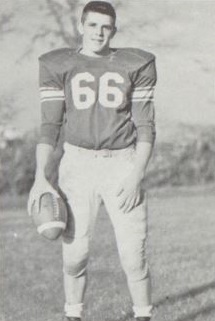 The Cardinals romped over the Midgets 27-0 in 1952 on their way to their first 8-0 season. There were only three undefeated U.P. teams that year, and the Floyd Barber Trophy – symbolic of gridiron supremacy above the straits – was awarded by the U.P. Sportswriters Association to Menominee, which finished 7-0 and had won its last 15 games.
The Cardinals romped over the Midgets 27-0 in 1952 on their way to their first 8-0 season. There were only three undefeated U.P. teams that year, and the Floyd Barber Trophy – symbolic of gridiron supremacy above the straits – was awarded by the U.P. Sportswriters Association to Menominee, which finished 7-0 and had won its last 15 games.
Wakefield fell to Hurley, 14-0, in 1953 and 38-14 in 1954. A 32-13 victory by the Cards in 1955 cemented the annual battle as a highlight of the schedule.
Attendance issues and stellar success
“Wakefield football teams seem to be a drawing card in every football stadium except their own,” wrote the Wakefield News in mid-September 1954. “The local populace has never really supported football as other range towns have. … This fact is surprising, especially since local teams have been extremely successful.”
In an attempt to improve local support, in 1957, Hurley and Wakefield again became conference rivals when the Cards returned to the Michigan-Wisconsin league from the Western Upper Peninsula Football Conference.
“The recommendation of the change of conferences was made by Coach Roman Yatchak to draw a larger attendance at football games,” stated the Globe. Contests with foes from the Western U.P. Conference, all 50 to 110 miles in distance from Wakefield, simply didn’t capture the attention of local fans. With the change, league contests would be no more than 50 miles away – the longest when they needed to travel to Ashland.
The Cardinals finished 3-1 in the M-W Conference in 1957 and 6-2 overall that first year. In the fall of 1958, Wakefield ran the table, ending the year with the M-W crown and a flawless 8-0 record on the season, the best in school history. Wakefield outscored its opponents 234-26.
Yatchak’s team had included 13 returning lettermen including four regulars. Dick Koski, winner of 12 varsity letters at Wakefield, was much of the reason for the success. At season’s end, he was named to the Detroit Free Press’ Class C all-state team backfield. He netted 943 yards from scrimmage and finished as the third-highest scorer in the U.P. with 106 points. Teammate Jerry Bugni earned honorable mention recognition.
(Koski would go on to star at Northern Michigan College, then coach high school ball, guiding Ontonagon for three seasons and then Negaunee for 31 more. He retired following the 1999 season with a 211-113-1 record).
Despite the perfect mark, Wakefield finished the season ranked No. 7 in Class C-D by United Press International in its 1958 season-ending prep ratings. Charlevoix was the leading vote getter in the classification according to UPI’s panel of 21 top high school coaches. The Barber Trophy again went to Menominee. Wakefield, which finished second in the voting, was one of five undefeated U.P. teams that year.
A loss in the final 60 seconds of play, again to Ironwood, was the single flaw on the Cardinals’ 1959 slate. The team ended the year ranked 10th in the final UPI Class C-D rankings.
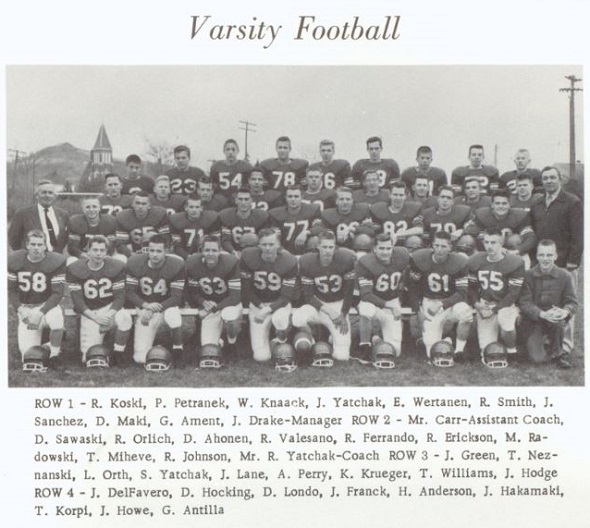
State Champs
Maki’s favorite, the 1960 squad, included 12 seniors. Ontonagon, winner of one game in 1959, dropped from the schedule, leaving Wakefield with only seven games as the season opened. About a dozen schools in Michigan and Wisconsin had been contacted in an effort to secure an opponent for the early October date. Despite Yatchak’s best efforts, he couldn’t find a replacement.
A Friday night blockbuster kicked off the season. At Longyear Field in Ironwood, a crowd of 3,000 lined the grounds on a warm, humid night for the rematch between the ’59 Michigan-Wisconsin Conference co-champs. Tied at 7-7 at the end of the first quarter, Wakefield opened a 21-7 lead as the teams headed to the locker room for halftime. Ironwood took the opening kick of the second half 11 yards to its 28, and then mounted a 10-play, 72-yard drive for a touchdown. A low kick kept the margin at eight. 21-13.
“Shortly after that the Red Devils were unable to capitalize on two golden opportunities to score following the recovery of Wakefield fumbles,” stated the Globe in its coverage the following day.
Ironwood snagged the first bobble on the Cardinals’ 32-yard line, but Wakefield held firm, allowing only seven yards on four plays: “Ironwood lost a certain touchdown when an end dropped a pass just a few steps from the goal line.”
The Red Devils grabbed the second fumble at the Wakefield 13, but the Cardinals’ unrelenting defense drove Ironwood back to the 17-yard line. An attempted field goal on fourth down sailed beneath the crossbar. From there, “neither team made a serious threat.”
For Wakefield, there were really no other major threats for the remainder of the season.
The Cards topped a strong Houghton 11 on a beautiful sunny Saturday by a score of 20-7 before a home crowd of 1,000. Again, an inopportune fumble by the hosts at their own 21 was snuffed out in four downs by the staunch Wakefield defense.
Next came conference victories over Bessemer, 40-0, Ashland, 20-6, and Hurley, 46-6. The win at Hurley was highlighted by a 50-yard interception return by Bob Orlich and an 81-yard kickoff return for a touchdown by Dewey Maki that opened the second half. Dave O’Leary, Hurley’s signal caller, picked up a Wakefield fumble and streaked 90 yards for the Midgets’ only points in the contest.
With the wins, the Cardinals secured the M-W championship and jumped from third place to first place in UPI’s weekly ratings, replacing Imlay City as the state’s top team in the Class C-D listings.
Despite continued efforts, no opponent could be found for the open date. When the team returned to action in mid-October, it squared off against Iron River. A 61-yard touchdown run by Tom Miheve on the second play of the game opened the scoring. Bob Erickson’s 31-yard TD dash followed. Then Dewey Maki “streaked 58 yards up the middle” in tallying the Redbirds’ third score. Miheve capped the scoring in the fourth quarter, whizzing 57-yards for his second TD as Wakefield grabbed a 27-0 road win before 2,500 at Nelson Field.
“Roman had the same personality traits as Coach Vince Lombardi of the Green Bay Packers. They were clones of one another,” said Russ Maki, describing the coach based on observation and conversations with former players in the years to come. “Yatchak was such a perfectionist. He’d have the players run a play, say an end sweep, over and over, six, seven times, maybe more, until it was perfect.”
The coach yelled and instructed and blew his whistle at afternoon practices audible to residents of the surrounding neighborhood.
“Mothers quickly learned to recognize signs to when practice was wrapping up, and the players were headed for the showers. It was time to cook the roast beef,” added Maki. “Their sons would be home in an hour.”
The season-ending contest with Calumet was a track meet, with the Cardinals steamrolling the Copper Kings 61-7 at Agassiz Field in Calumet on Friday, October 21.
According to the Globe:
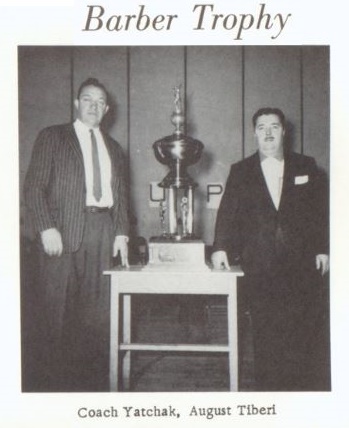 “Shifty Tom Miheve registered three markers, Bob Erickson, power-driving fullback added three more, followed by Dewey Maki, Bob Koski and Tom Neznanski each with a TD apiece. Bob Orlich added three extra points and Miheve, Erickson, Bob Smith and Pete Petramek each posted one.”
“Shifty Tom Miheve registered three markers, Bob Erickson, power-driving fullback added three more, followed by Dewey Maki, Bob Koski and Tom Neznanski each with a TD apiece. Bob Orlich added three extra points and Miheve, Erickson, Bob Smith and Pete Petramek each posted one.”
Still topping the UPI rankings after the game, now all Wakefield could do was wait for the rest of the state to finish the schedule.
On Saturday, November 5, the Upper Peninsula Sportswriters Association gathered in Iron Mountain and awarded the Barber Trophy to Wakefield. The trophy was presented to Coach Yatchak and captain Bob Erickson at a special assembly at the high school on Monday.
The Cardinals had ranked No. 35 in Hal Schram’s Top 50 teams in the state, regardless of size, published in November in the Detroit Free Press. It was an impressive accomplishment for the little U.P. squad, especially when one considered 675 schools in Michigan sported prep football teams.
It would take until after Thanksgiving weekend – more than a month – before the UPI coaches panel would announce its final poll.
Word finally appeared in print in the SHORTS IN SPORTS column in the December 1 edition of the Wakefield News, which was published weekly.
“Congratulations this week go to: Wakefield Cardinal football team for being named top Class ‘C’ team in Michigan by United Press International.”
The city with a population of 3,231 celebrated its first (and only) mythical state football championship.
The annual Fourth of July parade included a red flatbed truck, adorned with an ornamental goal post and a large banner that read “State Class C Champs.” Four players, dressed in their uniforms, stood on the bed, carrying footballs.
Yatchak’s 1961 team extended the win streak to 14 games (and 25 wins in 26 dating back to 1957) with victories in its first two games before falling to Bessemer in a heartbreaker, 13-7. It would be the only loss of Wakefield’s seven-game season.
Following the 1961-62 school year, Yatchak departed Wakefield to help develop the athletic program at newly-opened Lansing Waverly High School. His Cardinals teams had posted 90 wins and two ties over his 15 years in charge, against only 25 losses.
Changing landscape
The coming years saw plenty of regular-season success, but no team would match the accomplishment of the 1960 squad. Mythical state titles, where state championships were determined by press polls and media input, were replaced in 1975 by MHSAA championships decided by postseason play.
“The Sunday Lake mine closed in 1961. They employed 225 guys. It was a big deal,” recalled Maki. Between the mine’s first shipment in 1885 and closing, Sunday Lake had raised an estimated 17 million tons of ore. Between 1960 and 1970, Wakefield’s population plunged by nearly 15 percent to 2,757. “A lot of people left for mining work elsewhere in Michigan, Wisconsin, Minnesota, Arizona.”
Maki himself made honorable mention all-state in 1970 as a senior when the Cards went 6-2 with losses to Hancock and Hurley.
“Dick Koski had a brother who was the same age as me. He was as good as Dick, maybe better. The Koski family left. There’s no doubt in my mind that we would have won some basketball state titles, maybe another Barber Trophy if they stayed. You just don’t know.”
The Gogebic area did see its fortunes improve, but the reprieve wouldn’t last.
“White Pine, a little town about 35 miles northeast of Wakefield, had a small copper mine. Digging deeper they found new veins of copper. All of sudden, they (needed workers). I remember five charter busses would line up near the football field each morning to take people to work there. That was happening all around the area.”
“Of the more than 3,000 workers at White Pine Copper Mine, less than 1,000 live here,” noted the Ironwood Daily Globe in September 1971. “Many workers commute great distances – some up to 90 miles each day.”
 However, uncertainty and layoffs began in 1975 and 1976. Employment dropped in half or more. In 1995, the mine shut down completely.
However, uncertainty and layoffs began in 1975 and 1976. Employment dropped in half or more. In 1995, the mine shut down completely.
Wakefield’s 1991 football team was the first to qualify for the MHSAA postseason and won its opening-round contest with Central Lake before falling to Lake Linden-Hubbell in Class DD. The 1998 and 2000 teams also qualified.
Dropping student enrollment was impacting athletic programs at schools across upper and lower Michigan, including at Wakefield. Between 1985 and 2003, enrollment had fallen from 225 to 100. Following the 2003-04 school year, Wakefield consolidated with Marenisco, a district located 15 miles southeast. Still, for a variety of reasons, enrollment continued to drop. In 2009, Wakefield-Marenisco entered a co-op with Bessemer for football, and that fall, the Gogebic Miners were formed. Past rivals became teammates.
The rivalry with Hurley had been resurrected in 2000 and continued through the 2017 season. That school year, Ironwood joined the co-op, supplied the football schedule and its home field for the games.
In 2018, games were played at Bessemer. With enrollment now determined by combined school totals, the Wisconsin schools on the Gogebic schedule were replaced with games against Negaunee, Ishpeming Westwood and Iron Mountain, each with similar-sized enrollments.
The Dick Koski Trophy, a new entry in the state’s collection of rivalry hardware, also was created in 2018. Awarded annually to the winner of the Negaunee-Gogebic game, it celebrates Koski’s connection to Wakefield and Negaunee.
This season, home contests are staged at Ironwood. In 2020, the games are scheduled to move to Wakefield.
Celebration
Maki hopes a lesson in history may help inspire future kids, so he’s been doing his homework.
“They have banners honoring conference champions,” he said.
If all goes as hoped, a new banner could be unfurled in time to celebrate the 60th anniversary of the 1960 championship.
“I am scheduled to speak at the next Wakefield school board meeting in late October to try to get this team some recognition such as a pennant to hang in the gym,” added Maki, also noting a desire for a public dedication, perhaps during Wakefield’s annual Independence Day celebration. “A lot of people come back to watch the fireworks.”
Now, wouldn’t that be a blast!
 Ron Pesch has taken an active role in researching the history of MHSAA events since 1985 and began writing for MHSAA Finals programs in 1986, adding additional features and "flashbacks" in 1992. He inherited the title of MHSAA historian from the late Dick Kishpaugh following the 1993-94 school year, and resides in Muskegon. Contact him at [email protected] with ideas for historical articles.
Ron Pesch has taken an active role in researching the history of MHSAA events since 1985 and began writing for MHSAA Finals programs in 1986, adding additional features and "flashbacks" in 1992. He inherited the title of MHSAA historian from the late Dick Kishpaugh following the 1993-94 school year, and resides in Muskegon. Contact him at [email protected] with ideas for historical articles.
PHOTOS: (Top & 5) The 1960 Wakefield team is celebrated in the school’s yearbook for the 1960-61 school year. (2) An Ironwood Daily Globe advertisement announced a local store would guarantee a ham to every Wakefield player for a win over Hurley in 1929. (3) Roman Yatchak and Vernon Carr led Wakefield to its greatest football glories. (4) Dick Koski starred on the field for Wakefield before becoming a legendary coach. (6) Wakefield earned the Barber Trophy as the Upper Peninsula’s best team of 1960. (7) The Dick Koski Trophy is awarded annually to the winner of the Negaunee/Gogebic football game. (Photos gathered by Ron Pesch.)

